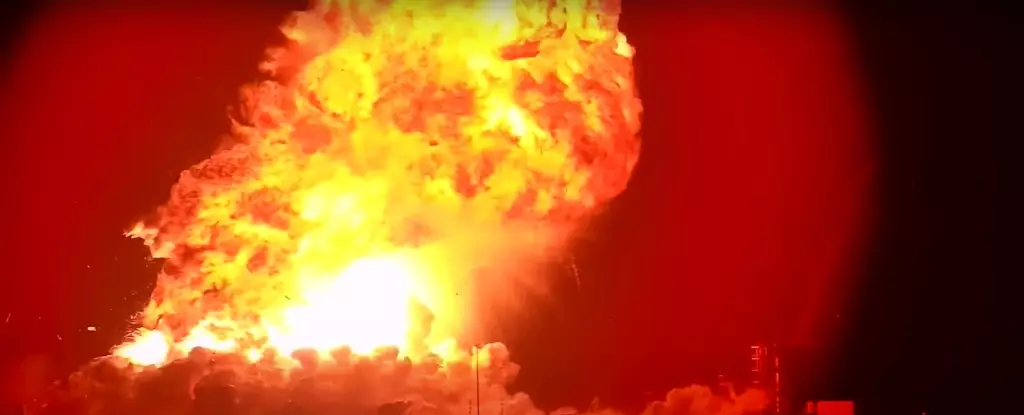In a high-stakes venture that encapsulates the audacious spirit of space exploration, SpaceX experienced yet another failure during a routine static fire test of its Starship rocket at the Starbase facility in Texas. The late-night test, which aims to prepare the rocket for its ambitious space missions, resulted in a catastrophic explosion that sent plumes of fire spiraling into the sky. As Elon Musk’s dream of a human colony on Mars continues to unfold, the latest incident represents not just a technical setback but a testament to the volatile nature of space exploration.
SpaceX’s frank acknowledgment of the explosion, which occurred at around 11:00 PM local time, signals both transparency and resilience. The company reported the event as a “sudden energetic event” leading to the destruction of the Starship, and fortunately, stated that safety protocols were upheld, ensuring the safety of all personnel involved. However, it begs the question: how many more setbacks can SpaceX withstand while working towards its ambitious objectives?
The Context: Grounds for Optimism Amid Disappointments
To understand the implications of this latest explosion, we must contextualize it within a string of previous failures that have punctuated SpaceX’s journey. Just months ago, another Starship prototype perished in an explosion over the Indian Ocean, and prior instances witnessed components of the spacecraft disintegrating mid-flight. While failures are a common occurrence in aerospace engineering, the frequency of these incidents raises concerns regarding the robustness of SpaceX’s technology and its readiness for the ultimate challenge: a human mission to Mars.
Many in the field, however, argue that SpaceX’s approach—championing the “fail fast, learn fast” mantra—might eventually yield dividends. Musk’s sensibility to take risks in a highly competitive domain reflects a steadfast belief that innovations often demand iterative troubleshooting. This philosophy not only targets rapid development but aims to expedite improvements that could lower costs and improve safety in future flights.
In stark contrast to traditional aerospace paradigms, SpaceX’s radical strategy embraces risk as an essential part of the engineering process. The rapid introduction of technological revisions and the agility to adapt are hallmarks of SpaceX’s mindset. The company has already demonstrated remarkable capabilities, such as safely catching the Super Heavy booster using robotic arms—a hallmark of modern engineering that could redefine reusability in the industry.
Innovation vs. Environmental Concerns
While SpaceX continues to push boundaries in aerospace innovation, environmental considerations loom large. The Federal Aviation Administration’s recent approval to raise the number of Starship launches from five to 25 per year sparked objections from conservation groups concerned about the ecological implications of increased activity. These entities argue that the expansion could jeopardize local wildlife, particularly sea turtles and various bird species in the vicinity of the launch sites.
Balancing technological advancement with environmental stewardship is a pressing issue that SpaceX must navigate as it forges ahead in its quest for interplanetary colonization. It’s crucial to consider that while innovation fuels progress, it must be pursued responsibly to minimize adverse effects on our planet and its ecosystems.
Public Perception: A Mixed Landscape
Public perception of SpaceX’s repeated challenges is complex. For some, each explosion signifies a step back, a reminder of the risks associated with ambitious projects. Others view these setbacks as integral to a learning process that is expected to yield transformative breakthroughs over time. Elon Musk himself, with his characteristic bravado, brushed off the recent explosion by labeling it “just a scratch,” underscoring his unwavering commitment to perseverance in the face of adversity.
As SpaceX approaches its anticipated milestones, the stakes are undoubtedly high. The emphasis on rapid testing and iterations is rooted in a quest to not only achieve successful flights but to make space travel an everyday reality. This journey is as much about technological feats as it is about public faith—confidence that SpaceX can overcome its hurdles and deliver on promises of interplanetary exploration and colonization.
In an era where dreams of space travel capture the public imagination, SpaceX represents both humanity’s finest aspirations and the stark realities of what it means to navigate the cosmos. The fusion of ambition, risk, and innovation carries lessons not just for the aerospace industry, but for all fields driven by exploration and discovery.


Leave a Reply